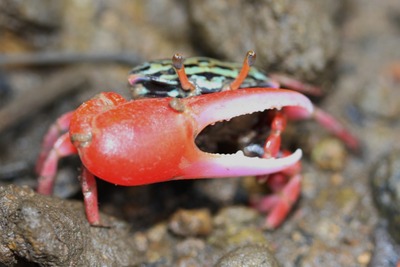WAVING BEHAVIOUR OF FIDDLER
CRABS: HOW, WHY, AND WHEN
MALES WAVE THEIR CLAWS
The name ‘fiddler crab’ refers to over a hundred species within eleven genera of Ocypodidae, a family of semi-terrestrial crabs (Rorato, Araujo, Perez, & Pie, 2017). They are sexually dimorphic crabs, with the males sporting enlarged major claws: this is in contrast to their minor claws, which are used to gather food (How, Zeil, & Hemmi, 2007). Females possess two minor claws of equal size (How et al., 2007). These animals live on the mudflats that exist in the path of an ocean’s tide (“intertidal”) or in intertidal mangrove forests, emerging from their solitary burrows when the tide is low to forage and interact with other members of their species. Due to this, populations of fiddler crabs can be large and concentrated very densely in a single area (Zeil & Hemmi, 2006). As foraging animals, fiddler crabs mainly eat detritus and algae washed in from the ocean’s tide. Their eyestalks allow them three hundred and sixty degrees of range in their vision, though they can do little more than detect motion, especially from long distances (Zeil & Hemmi, 2006).
Fiddler crabs are an extremely popular animal to study due to the nature of their colonies and the inherent complexity of their signalling systems (Backwell, 2019). It is relatively easy to conduct studies on populations of these crabs, who live in massive mixed-sex colonies and react neutrally to handling (Rorato et al., 2017). Their reliance on visual cues makes them unique in the animal world; a number of adaptations related to the lifestyle of the fiddler crab have to do with responses to visual signals (Zeil & Hemmi, 2006).
During the reproductive season, fiddler crabs engage in courtship; in many species the female chooses a male to mate with (deRivera, Backwell, Christy, & Vehrencamp, 2003). As a result, male fiddler crabs wave their enlarged major claws during courtship displays in order to impress passing females; once a female crab chooses a male, they mate underground in the male’s burrow (Backwell, Jennions, Wada, Murai, & Christy, 2006). Although this is the main function of claw waving, males may also wave to ward off rival males or to defend their territory (How et al., 2007).

"Fiddler Crab (Uca Crassipes?)" by Thomas Brown is licensed under CC BY 2.0
An example of a male fiddler crab, with one claw much larger than the other.
It is recommended to view the following pages in order:
The “Waving” page details the different types of claw waving that male fiddler crabs exhibit, depending upon the context in which they display the behaviour.
The “Competition” page explains the evolutionary mechanisms that have led to the claw waving behaviours observed in male fiddler crabs.
The “Synchrony” page describes a special phenomenon observed in several species of fiddler crab during their group claw waving displays.
The “Gallery” page includes a variety of fiddler crab images.
The “Credits” page properly accredits every external source to its respective owner.
It is not recommended to view this website on mobile devices. If a page fails to load at any point, refreshing the website may help.